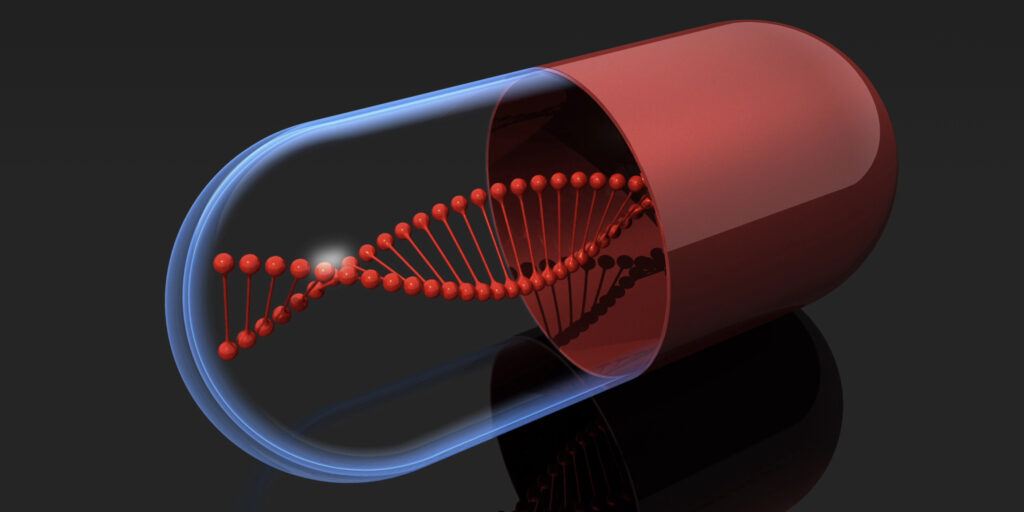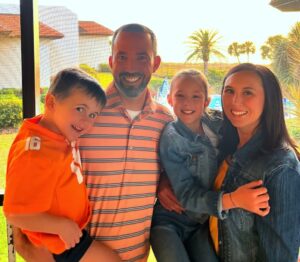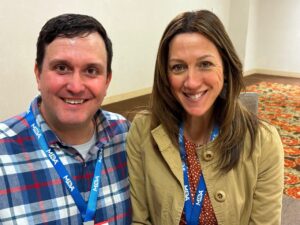
DMD Gene Therapy Approval Ignites Hope
By Larry Luxner | Tuesday, August 1, 2023
When news broke in June that the US Food and Drug Administration (FDA) had approved Sarepta Therapeutics’ gene therapy delandistrogene moxeparvovec (Elevidys) for 4- and 5-year-olds with Duchenne muscular dystrophy (DMD), Jessica Hubbard was overjoyed.
As MDA’s Manager of Community Education, Jessica is well aware that Elevidys is the first gene therapy approved to treat DMD, a degenerative condition affecting 11,000 boys in the United States. One of them is her son, Deacon, who turns 5 in August.
“He’s now on the shortlist to receive Elevidys,” says Jessica, who lives in Knoxville, Tennessee, with her husband and their two children.
Parents’ hopes and concerns
For the past two years, Deacon has been receiving intravenous infusions of Sarepta’s casimersin (Amondys 45), an exon-skipping drug, twice a year at the MDA Care Center at Nationwide Children’s Hospital in Columbus, Ohio.

The Hubbard family, from left: Deacon, Ryan, Emily , and Jessica
Amondys 45, along with three other Sarepta exon-skipping therapies on the market — Exondys 51, Vyondys 53, and Viltepso — have been shown to slow the progression of the disease in boys with mutations on specific exons. However, they require regular intravenous infusions.
Gene replacement therapies like Elevidys and other investigational therapies under development — such as Pfizer’s PF-06939926 and Solid Biosciences’ SGT-003 — are intended to be one-time treatments that replace the defective dystrophin gene. They could potentially help a wider group of kids with DMD, regardless of the exon with the mutation.
“My main concerns with gene therapy were the risk of cardiomyopathy [heart disease] and some other things we had heard about, but Deacon’s doctors don’t feel it’s a high risk because he’s otherwise a pretty healthy boy,” Jessica says. “My husband and I had a long conversation and ultimately decided this is something we want to do. This seems to be the best option of giving him a shot at a somewhat normal childhood.”
Years of work behind the gene therapy
Sharon Hesterlee, PhD, Chief Research Officer at MDA, says the recent approval of Elevidys represents a milestone for the organization that was years in the making.
“We have invested $125 million specifically in gene therapy — more than half of it in Duchenne,” she says. “The work Sarepta has done is really impressive, and it builds on all the time and money we’ve put into developing gene therapy, starting with the first trial we sponsored back in 1999 for limb-girdle muscular dystrophy (LGMD).”
Jerry Mendell, MD, was the principal investigator on that LGMD study. In 2006, Dr. Mendell, along with AskBio’s Jude Samulski, PhD, led the first clinical trial for a DMD gene therapy.
Gene therapy access
Given the fact that Elevidys is currently approved only for boys 4-5 years old, Dr. Hesterlee estimates between 1,200 and 1,300 boys are now eligible to receive the therapy.
She explains that the FDA specified this narrow window because, “the data were more supportive for the younger boys.” Researchers, clinicians and families in the neuromuscular disease community are hoping that window will be expanded.
“A phase 3 trial is ongoing, and depending on the results of that study the FDA may expand the label,” Dr. Hesterlee says.
Deciding on gene therapy

Chris and Jessica enrolled their son in a clinical trial for a gene therapy. Photo Credit: Larry Luxner
Parents who are on the fence about whether to give their boys a gene therapy drug should “go for it,” says Chris Curran of Ridgefield, Connecticut. His son Conner, now 12, was the first patient to receive an infusion of Pfizer’s PF-06939926 in 2018 as part of an ongoing clinical trial for the experimental gene therapy, which is not yet FDA-approved.
Conner, who has an exon 33 deletion and would not benefit from an available exon-skipping therapy, calls the gene therapy he received “muscle juice” because it not only stopped the muscle deterioration caused by DMD but improved his condition in some aspects.
“Soon after receiving the drug, Conner was able to do things he was never able to do before, like running up the stairs, jumping on both feet, and riding a bike,” Chris says. “He was able to take long walks with the family and not have to be picked up due to fatigue.”
Just as importantly, Conner’s self-esteem grew, as he was able to get in and out of the car without help, carry his own backpack at school, and join his friends during recess instead of watching them play.
Yet now that seven years have passed since Conner received the gene therapy infusion, Chris and his wife, Jessica, have noticed his strength is beginning to slowly decline. And as happy as they are that the FDA finally approved a gene therapy for DMD, they’re concerned that it’s only available for a limited age range and that these therapies may not truly be one-time treatments.
“That window is too narrow, as we all know,” Chris says. “We have to reach a broader population and figure out redosing, so these first-generation patients — and those that follow — can eventually be redosed and not left behind.”
To that end, MDA, along with two other nonprofits — Parent Project Muscular Dystrophy and CureDuchenne — recently announced they’d each kick in $100,000 to finance a one-year clinical study that will assess the safety and efficacy of efgartigimod alfa-fcab (Vyvgart) to lower adeno-associated virus (AAV) antibodies that prevent redosing and make some people ineligible to receive gene therapy in the first place.
The study, which involves 12 boys with DMD, will be led by Barry Byrne, MD, PhD, MDA’s Chief Medical Advisor and Director of the University of Florida’s Powell Gene Therapy Center.
Meanwhile, Chris won’t lose hope — not for his own son, and not for the thousands of boys with DMD who have yet to receive gene therapy of any kind.
“We are grateful for what he received, and we know with repeat administration and combination drugs coming down the pipeline, these patients will have a real chance to live long, full lives,” he says.
Next Steps and Useful Resources
- MDA’s Gene Therapy Support Network connects you to information, resources, and one-on-one support.
- Get the basics in MDA’s Virtual Learning webinar Gene Therapy 101.
- Watch a video about how MDA has led the way in gene therapy development research.
- Stay up-to-date on Quest content! Subscribe to Quest Magazine and Newsletter.
TAGS: Drug Approval, Exon Skipping, Featured Content, Gene Therapy, Research
TYPE: Blog Post
Disclaimer: No content on this site should ever be used as a substitute for direct medical advice from your doctor or other qualified clinician.




